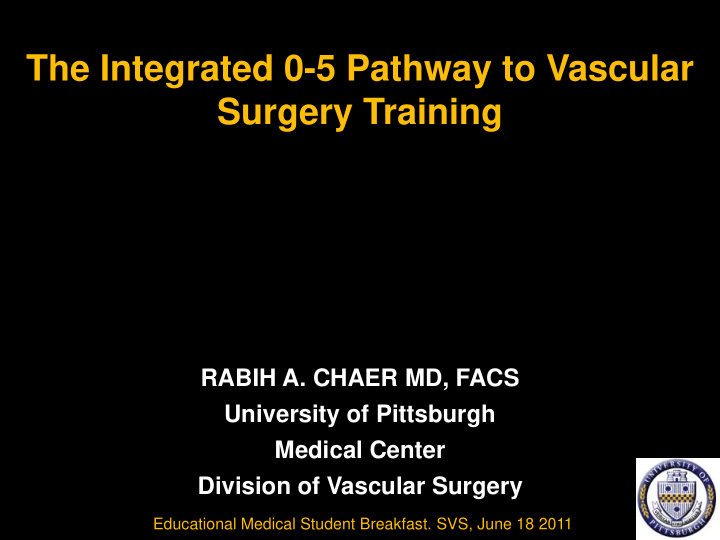



The Integrated 0-5 Pathway to Vascular Surgery Training RABIH A. CHAER MD, FACS University of Pittsburgh Medical Center Division of Vascular Surgery Educational Medical Student Breakfast. SVS, June 18 2011
Disclosures • NONE
Training in Vascular Surgery The Plunge Inaugural Year:2007 Dartmouth Pittsburgh Michigan
Integrated Vascular Positions offered/Yr 32 28 24 20 16 12 8 4 0 2007 2008 2009 2010 2011
Integrated program becoming one of the most competitive specialty matches: 8 to 1 ratio
What is the Imperative? Why do we need NEW Training Paradigms? 1. Vascular Surgery Has Changed Dramatically!
The Transformation of Vascular Surgery 1993
The Transformation of Vascular Surgery 2005
The Transformation of Vascular Surgery 1994
The Transformation of Vascular Surgery 2007
Vascular Spectrum: Partial Listing Spectrum of Vascular Surgery in 2011 is too wide Arch branches reconstruction Aorto-Inominate bypass Carotid Artery disease: TIA, Stroke Many different skill sets are required Carotid Endarterectomy CEA Carotid Artery Stenting CAS Endovascular Instrumentation is exploding Cerebral protection devices Vertebral artery reconstructions Knowledge base required is too vast Fibromuscular dysplasia Carotid body tumors Th i tl t d
General Surgery Woes • Vascular Surgery Fellowship after a General Surgery Residency is NOT EFFICIENT • The Identity of General Surgery is no longer clear
Bulletin of the ACS 2008;93:32-38
General Surgery as we knew it no longer exists GS has unrealistic expectations. It is attempting to train ALL surgeons to be “competent” in TOO many areas Vascular Surgery training is far too long. 7 +2 Serious Debt for students discouraging surgical careers Residents are starting at an older age : 26-30 J Vasc Surg 2001;34;826-30
General Surgery Woes • Nearly 100% of our GS graduates seek fellowships even in the traditional CORE of GS – Critical Care – Laparoscopy or minimally invasive surgery – Surgical Oncology – GI (pancreatic) – Endocrine – Colorectal – Liver Surgery • Acute Surgery Fellowships started in 2009 across the US
Integrated 0-5 Must Include: 36 months Vascular Rotations: Can include electives such as Cardiothoracic, Transplant, Interventional radiology, vascular Medicine… 24 Months Core Curriculum Basic Surgical Principles, ICU care, Nutrition, Abdominal Surgery….
Integrated 0-5 UPMC PGY 1 PGY 2 PGY 3 PGY 4 PGY 5 Month 1 Vascular Cardiology Vascular Vascular Vascular UPMC PUH UPMC Pass UPMC PUH Month 2 Vascular Vascular Month 3 Anesthesiology Gen surgery Vascular UPMC Shady Month 4 Gen Surgery Gen Surgery-VA Vascular Vascular UPMC St Marg UPMC Shady Month 5 Gen Surgery Gen Surgery Vascular UPMC PUH Month 6 Gen Surgery Gen Surgery Month 7 Gen Surgery VA Gen Surgery Vascular Vascular Vascular UPMC Shady UPMC Pass UPMC PUH Month 8 Trauma CT MR Imaging Month 9 Critical care Critical care Vascular UPMC PUH Month 10 Plastic Surgery Kidney transplant Vascular Vascular UPMC St Marg UPMC Shady Month 11 Thoracic Cardiac Surgery Vascular UPMC Shady Month 12 Cardiology Trauma
0-5 vs. 5-2 Vascular Procedures /Techniques and General Surgery Procedures /Techniques are increasingly diverging Laparoscopy vs Fluoroscopy Value of procedural training in general surgery somewhat limited (robotics, etc…)
Integrated Vascular Surgery Program 1) Provide a CORE training that is partially customized to VS General surgical principles: Infections, stress reactions, nutrition.. Critical care Advanced Imaging techniques: CT, MR, Workstations.. “Vascular Medicine” background: HT, Lipids, DM, coronary risk Exposure to abdominal and cardiothoracic surgery 2) Focus most procedural training to vascular procedures
The 0-5 Surgical Specialty Training Model • Allows Resident to clearly identify with a specialty service and help develop a vascular identity • Allows Residents to integrate clearly with the Fellows during their 3 Clinical Years • Sharing in call can allow quicker maturity and readiness • Two senior years allow for a more independent experience
This Model was made Easy by: • Multitude of Rotations on our services – 7 distinct ALL VASCULAR rotations. – 1 outpatient 6 inpatient – Some rotations have VS juniors and some GS juniors – All have Vascular trainees as seniors. • Large Faculty that staffs all the services
Assessment of our Integrated Program • May be too soon to be able to evaluate objectively • Surrogate markers – Number of cases – In-service scores
INTEGRATED RESIDENT first 3years Resident A Resident B experience Aneurysms 21 12 Cerebrovascular 17 15 Peripheral obstructive 108 87 Abdominal obstructive 3 3 Upper extremity 8 8 Extra-anatomic 6 6 Thrombolysis 15 16 Miscellaneous Endovascular Therapeutic 22 33 Trauma 8 15 Venous 25 85 Endovascular Diagnostic 38 72 Miscellaneous vascular 19 19 Vascular access 52 90 Amputations 46 61 TOTAL VASCULAR 388 522 General surgery cases 250 240
In training Exams 2010 ABSITE V site 3 rd Year residents • Interns: – 88 th percentile 85 th percentile – 52 nd percentile 79 th percentile • 2 nd year residents – 71 st percentile – 57 th percentile
0-5 PROs • Shorter, focused training • More exposure to vascular • Training as a vascular specialist: imaging, vascular medicine, etc.. • Vascular research, career planning • Earlier debt repayment
Will the Integrated residents be the equals of the Independent 5+2 Fellows? Maybe early to know! I would like to think that it is not a matter of being equal but equally competent in Vascular care!
Recommend
More recommend